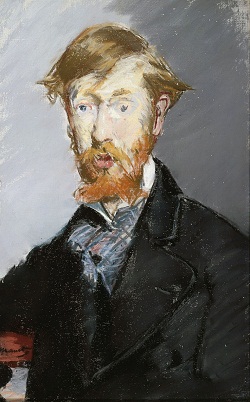How are you?
Currently, I am
introducing the stories about various artists and their paintings with the
title “Interesting
Art Stories”.
The 61st story is “L'Absinthe” by Edgar Degas.
“L'Absinthe” is a painting
by Edgar Degas between 1875 and 1876, and it is in the permanent collection of
the Musée d'Orsay in Paris.
 |
| Self-portrait, Edgar Degas (1855) |
The original title of the painting
was “Dans un Café” and other early titles were “A sketch of a French Café” and
“Figures at Café”. Then, when the painting was exhibited in London in 1893, the
title was changed to "L'Absinthe," which is now commonly known.
The painting depicts a woman and a man who appear lethargic and lonely, sitting side by side, drinking a glass of absinthe. The man in a hat is looking to the right off the edge of the canvas, while the woman in fashionable dress and hat is staring vacantly downward and a glass of absinthe is on the table in front of her.
The models in the painting are Ellen Andrée, an actress who also appears in Édouard Manet's paintings “Chez le père Lathuille” and “Plum Brandy” and Marcellin Desboutin, a painter and etcher. The café where they are is the Café de la Nouvelle-Athènes in Paris.
 |
| Ellen Andrée |
 |
| Chez le Père Lathuille, Édouard Manet (1879) |
 |
| Plum Brandy, Édouard Manet (1877) |
 |
| L'Artiste, Portrait of Marcellin Desboutin, Édouard Manet (1875) |
 |
| Café de le Nouvelle Athènes (before 1900) |
When the painting was first shown
in 1876, it was criticized by critics as ugly and disgusting. It was kept in
storage until it was displayed again in 1892, but was again the subject of
derision. The painting was then exhibited again at the Grafton Gallery in
England in 1893, with the title of “L'Absinthe”, where it sparked greater
controversy. English critics considered the people and the absinthe in the
painting as very degraded and uncouth.
 |
| The Octagon Gallery at the Grafton Galleries (1893) |
Many regarded the painting as a
blow to morality, which was the general view of Victorians such as Sir William Blake
Richmond and Walter Crane when the painting was displayed in London. That
response was typical of the period, revealing Victorian England’s deep
suspicion for the art in France since the early days of the Barbizon School and
desire to find morally uplifting lessons in artworks. Many English critics
viewed the painting as a warning lesson against absinthe and the French.
About the woman depicted in the
painting, novelist George Moore commented as "What a whore!" and
added, "The tale is not a pleasant one, but it is a lesson." However,
in his book “Modern Painting” later, Moore regretted giving a moral lesson to
the painting, arguing that "this painting is merely a work of art and has
nothing to do with drink or sociology".
 |
| Georges Moore, Edouard Manet (1879) |
Thank you.





No comments:
Post a Comment